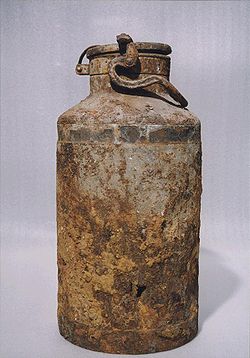Ringelblum Archive
| Compiled by Oyneg Shabbos group | |

One of the milk cans used to hide documents. From the Ringelblum "Oyneg Shabbos" Archive
|
The Ringelblum Archive is a collection of documents from the World War II Warsaw Ghetto, collected and preserved by the group known under code name Oyneg Shabbos (in Modern Israeli Hebrew: Oneg Shabbat, Hebrew: עונג שבת), led by Jewish historian Dr. Emanuel Ringelblum. The group, which included historians, writers, rabbis and social workers, was dedicated to chronicling life in the Ghetto during the Nazi occupation. They worked as a team, collecting documents and soliciting testimonies and reports from dozens of volunteers of all ages. The materials submitted included essays, diaries, drawings, wall posters and other materials describing life in the Ghetto. The collection work started in September 1939 and ended in January 1943.
Today the discovered part of the collection, which contains about 6,000 documents (about 35,000 pages), is housed at the Jewish Historical Institute in Warsaw.
The name Oneg Shabbat means joy of the Sabbath in Hebrew and usually refers to a celebratory gathering held after Sabbath services, often with food, singing, study, discussion, and socializing. This name was selected because the group tended to meet on Saturdays to discuss the progress of their collection and documentation efforts. The form Oyneg Shabbos is Ashkenazic pronunciation.
The members of Oyneg Shabbos initially collected the material with the intention that they would write a book after the war about the horrors they had witnessed. As the pace of deportations increased, and it became clear that the destination was the Treblinka death camp and few Jewish Varsovians were likely to survive, Ringelblum had the archives stored in three milk cans and ten metal boxes, which were then buried in three places in the Ghetto. Two of the canisters, containing thousands of documents, were unearthed on 18 September 1946 and a further ten boxes on 1 December 1950. The third cache is rumored to be buried beneath what is now the Chinese Embassy in Warsaw but a search in 2005 failed to locate the missing archival material.
...
Wikipedia
